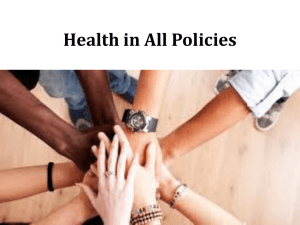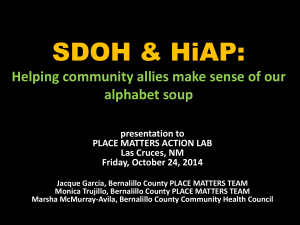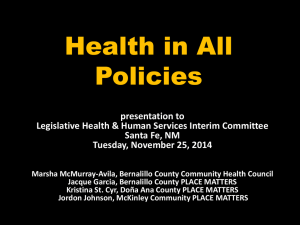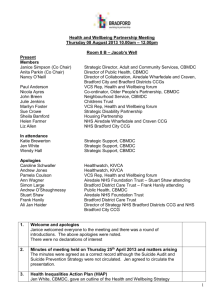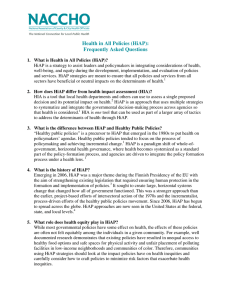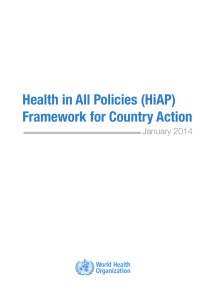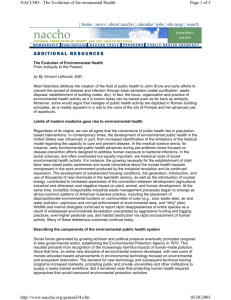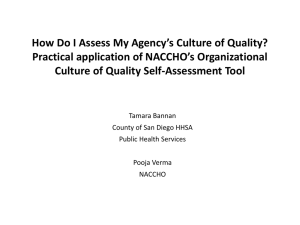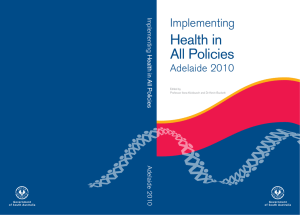Health in All Policies (HiAP): A Path to Promoting Environmental Public Health
advertisement
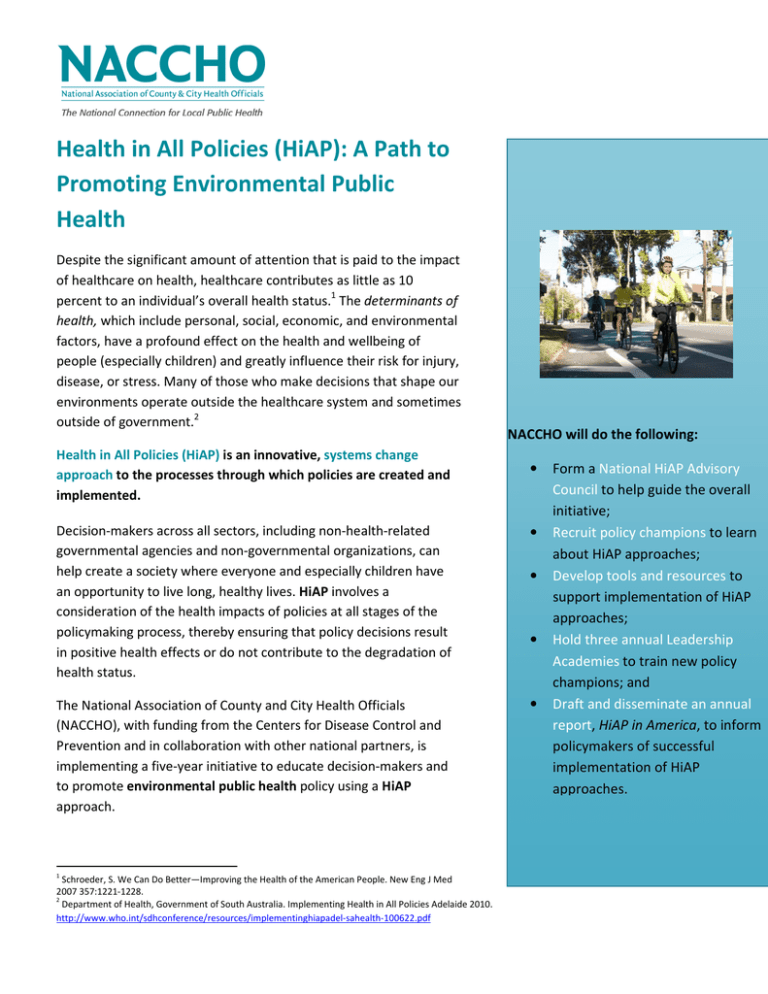
Health in All Policies (HiAP): A Path to Promoting Environmental Public Health Despite the significant amount of attention that is paid to the impact of healthcare on health, healthcare contributes as little as 10 percent to an individual’s overall health status.1 The determinants of health, which include personal, social, economic, and environmental factors, have a profound effect on the health and wellbeing of people (especially children) and greatly influence their risk for injury, disease, or stress. Many of those who make decisions that shape our environments operate outside the healthcare system and sometimes outside of government.2 Health in All Policies (HiAP) is an innovative, systems change approach to the processes through which policies are created and implemented. NACCHO will do the following: • Decision-makers across all sectors, including non-health-related governmental agencies and non-governmental organizations, can help create a society where everyone and especially children have an opportunity to live long, healthy lives. HiAP involves a consideration of the health impacts of policies at all stages of the policymaking process, thereby ensuring that policy decisions result in positive health effects or do not contribute to the degradation of health status. • The National Association of County and City Health Officials (NACCHO), with funding from the Centers for Disease Control and Prevention and in collaboration with other national partners, is implementing a five-year initiative to educate decision-makers and to promote environmental public health policy using a HiAP approach. • 1 Schroeder, S. We Can Do Better—Improving the Health of the American People. New Eng J Med 2007 357:1221-1228. 2 Department of Health, Government of South Australia. Implementing Health in All Policies Adelaide 2010. http://www.who.int/sdhconference/resources/implementinghiapadel-sahealth-100622.pdf • • Form a National HiAP Advisory Council to help guide the overall initiative; Recruit policy champions to learn about HiAP approaches; Develop tools and resources to support implementation of HiAP approaches; Hold three annual Leadership Academies to train new policy champions; and Draft and disseminate an annual report, HiAP in America, to inform policymakers of successful implementation of HiAP approaches. NACCHO’s Environmental Public Health (EPH) HiAP Project will identify, recruit, and educate decision-makers across the nation to increase awareness among decision-makers about the health implications, especially environmental public health implications, of policy and not just policies explicitly related to health. These decisionmakers will learn how HiAP principles can contribute to the policymaking process at all levels of government (or in organizations) and have a beneficial impact on the determinants of health even while fulfilling the original (non-health) objectives of the policy. EPH Health in All Policies (HiAP) Project In recognition of the need to educate decision-makers about the influence of their decisions on environmental public health, NACCHO’s EPH HiAP Project will include three focus areas: • • • Children’s environmental health; Core environmental health services; and Toxic chemical exposures. NACCHO will draw on nationally recognized scientists and other experts in these three fields to provide advanced training to the policy champions recruited for training opportunities. The immediate outcome of this project will be the creation of engaged and informed policy champions who are aware of how their decisions impact the determinants of health, are knowledgeable about promoting environmental public health policy using a HiAP approach in the policy formulation process, and have access to educational materials and resources to implement HiAP approaches in their home districts. HiAP National Partners: • • • • • • National Association of County and City Health Officials Association for State and Territorial Health Officials National Association of Local Boards of Health National Conference of State Legislatures Children’s Environmental Health Network American Public Health Association For more information, visit www.naccho.org Contact: Kenneth D. Smith, PhD Lead Senior Analyst hiap@naccho.org 202-756-0162 This publication was supported by Cooperative Agreement EH11-1110 from the Centers for Disease Control and Prevention. Its contents are solely the responsibility of the authors and do not necessarily represent the official views of the Centers for Disease Control and Prevention.
